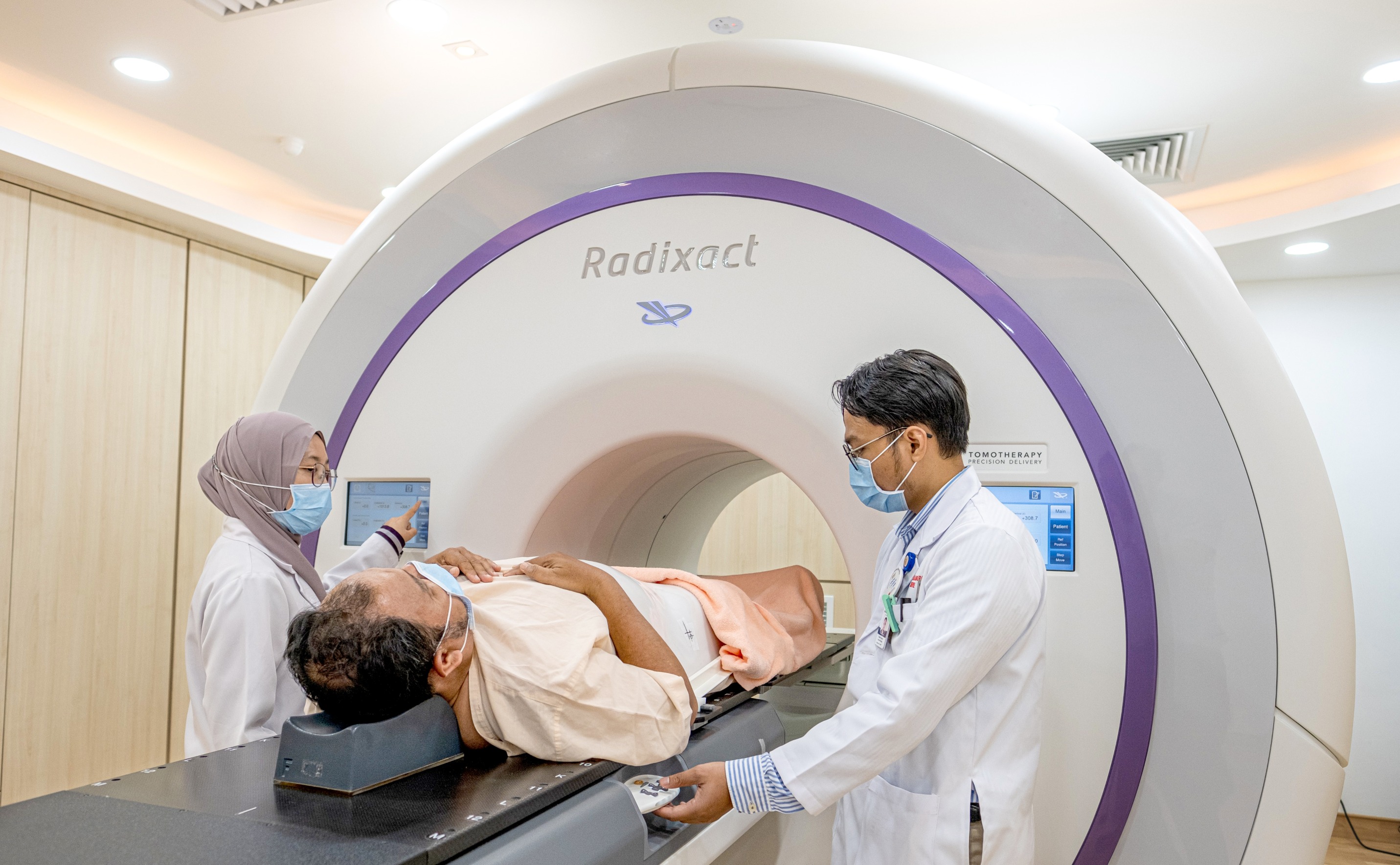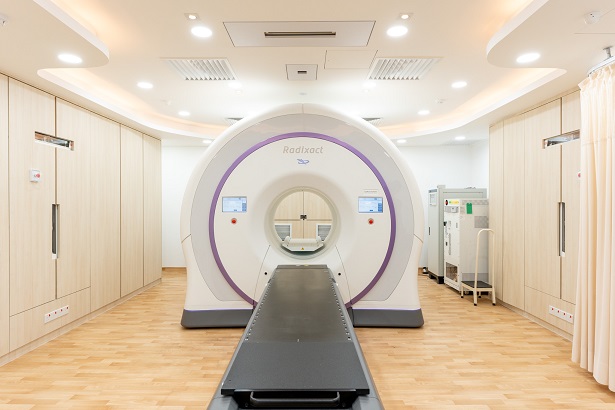Leveraging Cutting-Edge Technology For Precise Cancer Treatment
As technology integrates into the healthcare field, or even breaks the boundaries between drugs and therapies, medical teams are empowered to provide more accurate diagnoses and efficient treatments for patients. This enhances patients' medical experiences and holds the potential to contribute to a healthier future for all.
Cancer undoubtedly carries negative connotations, often associated with death, suffering, struggle, and incurability. Ischemic heart disease and cancer rank among the leading causes of death in Malaysia.
For most common cancers, early diagnosis can improve survival rates. Coupled with appropriate treatments and healthy lifestyles, patients can better control and manage their diseases. Furthermore, global advancements in medical capabilities, particularly in the field of tumour and cancer treatment, have led to the emergence of various new-generation drugs and technologies, offering new hope to patients.
Regarding tumour and cancer treatment, one advanced technology involves the combination of precise intensity-modulated radiation therapy and image-guided scanning. This approach is used to target and shrink tumours while minimising radiation impact on surrounding healthy cells.

Radixact X9 Tomotherapy with Synchrony utilises real-time motion synchronization to track patients' respiratory stability.
Enhanced Precision in Treatment
The latest Radixact X9 system incorporates real-time motion-synchronized tracking through helical Tomotherapy with Synchrony. It utilises real-time motion synchronization to track patients' respiratory stability while delivering highly precise stereotactic body radiation therapy (SBRT) directly to the local tumour.
This also means that this cutting-edge system has high precision in tracking tumours that move along with the body's natural breathing during treatment, such as primary or metastatic lung cancer, liver cancer, prostate cancer, and pancreatic cancer. It has also shown outstanding performance in clinical trials, especially for cases involving the head, neck, chest, gastrointestinal tract, and prostate.
Experts in oncology and urology from Subang Jaya Medical Centre (SJMC) provide insights into this latest medical system and technology from different perspectives, sharing their professional knowledge and treatment recommendations.
Lung Cancer: Malaysia's Third Most Common Cancer
According to data cited from GLOBOCAN by WHO, cancer is the second leading cause of global deaths. Malaysia has also seen a rising trend in the number of cancer patients, with 48,639 new cases reported in 2020, and this figure is expected to double by 2040.
While cancer cells can appear anywhere in the body, lung cancer accounts for 10.6% of the most common cancers in Malaysia, ranking second only to breast and colorectal cancers. According to Malaysia National Cancer Registry Report 2012-2016, most lung cancer patients fall within the age range of 60 to 74 years, and a staggering 93.5% of male patients and 92.3% of female patients are diagnosed at later stages.
Dr. Yap Beng Khiong, consultant clinical oncologist at Subang Jaya Medical Centre, highlights that lung cancer is the third most common cancer in both men and women in Malaysia. As over 90% of patients are diagnosed at later stages, the mortality rate is high, hence, timely treatment is very important.

According to Dr. Yap Beng Khiong, more than 90% of lung cancer patients are diagnosed at later stages.
1 in 117 Males Affected by Prostate Cancer
As for prostate cancer, in Malaysia, there was an increase of as much as 9.3% in the number of men diagnosed with prostate cancer in 2020, ranking second only to lung and colorectal cancer.
Dr. Peter Ng Eng Pin, consultant urologist at Subang Jaya Medical Centre, noted that from 2007 to 2011, prostate cancer was considered the third most common cancer in Malaysia, with the possibility of one out of every 117 males being affected by the disease.
"However, residents in some rural areas of the country might be diagnosed later. There are no widespread screening programs in the community to obtain clearer data."
Conventional Treatment Approaches for Lung and Prostate Cancer
In lung cancer treatment, the approach used to target cancer cells conventionally considers both normal lung tissue and tumour cells, while taking into account the patient's movements, such as their breathing. Therefore, doctors needed to widen the treatment area to encompass the area affected during the patient's breathing cycle.
Dr. Yap Beng Khiong pointed out that radiotherapy is primarily used for early-stage localised tumours without metastasis.
"The lungs are a moving organ influenced by our breathing motion, which makes treatment challenging."
Prostatectomy, the removal of the prostate, has been the traditional treatment approach for early-stage prostate cancer patients. However, radiotherapy is also effective for patients in stages one to three and occasionally selected cases of stage four.
He mentioned that when surgery is not preferred, radiotherapy becomes a key treatment approach, especially for elderly or those who might have other health conditions. Radiotherapy can also be combined with hormonal therapy, such as androgen deprivation therapy (ADT), to reduce testosterone levels.

Dr. Peter Ng stated that one out of every 117 males is affected by prostate cancer.
Conventional Treatment Methods Have Stronger Side Effects
Dr. Peter Ng added that for prostate cancer, conventional radiotherapy can span over 5 weeks, requiring 10 to 15 minutes of treatment per session for five days a week. This ensures the sufficient dosage is delivered to the prostate cancer site.
"Other issues from conventional treatment methods include collateral damage to surrounding normal organs such as the bladder, rectum, and urethra. These effects can be acute or long-term, causing debilitation to the patient and lowering their quality of life. Therefore, treatment needs to strike a balance between the dosage of radiation therapy and the risk of collateral damage."
He stated that another conventional or acceptable treatment approach is brachytherapy, which involves implanting radioactive seeds directly into the prostate to release low doses of radiation, combating cancer cells within the prostate rather than emitting radiation externally, thus reducing the collateral damage.
Synchronized with Patient Breathing for Accurate Tumour Tracking and Treatment
As precision medicine technology develops rapidly, radiotherapy's accuracy also improves. Artificial intelligence can track tumor movement in sync with a patient's breathing, known as in-motion tracking.
According to Dr. Yap, Tomography with Synchrony allows precise tracking of tumor synchronized with breathing movements.
"The benefits include reduced impact on normal lung tissue surrounding the tumor and sparing it as much as possible to minimise side effects and toxicity. Additionally, this type of focused treatment allows for the use of high-doses radiation, which is called Stereotactic Body Radiation Therapy (SBRT). It is suitable for patients with early-stage, low to moderate risk and localised tumours."
He doesn't rule out the possibility that, with accumulating treatment cases, this technology might be used for more later-stage cancer patients, such as some lung metastasis in a small field; wherein SBRT can target the lung while other parts of the tumor can be treated with targeted therapy. For lung cancer, SBRT might require three to five treatment sessions and can be completed within one to two weeks, reducing lung damage and patient inconvenience.

Injecting a rectal spacer into the space between the rectum and the prostate helps prevent the rectum from being affected by radiation.
Using Special Gel Spacer to Reduce Complications
Dr. Peter Ng pointed out that, in treatment for prostate cancer, the new SBRT technology delivers the entire dose of radiation within a shorter time, typically five to six days, compared to conventional intensity-modulated radiation therapy (IMRT), which requires up to five weeks of treatment. It is effective for certain grade of prostate cancer cases, offering high local control rates and low impact on normal tissues.
SBRT's targeting of prostate cancer cells is highly accurate, especially with urologists using gold fiducial markers as guides. Additionally, injecting a special gel called Barrigel into the space between the rectum and the prostate creates a barrier, preventing a lot of the rectum from being affected by radiation.
Low Complications and Greater Convenience for Patients
Dr. Yap Beng Khiong pointed out that age does not restrict SBRT; its suitability depends on the patient's physical condition. With more experience in future, the doctors aim to offer treatment to more patients with advanced cancer in the future.
"The benefits for patients are quite significant. For example, there is a patient from Sabah opted for radiotherapy, in the past, he would have needed to stay in Kuala Lumpur for 5.5 weeks for conventional radiotherapy. However, with SBRT, he only needed to stay for a week, making his treatment journey more convenient."
“Despite being in his 70s, this patient didn't experience rectal complications, only encountering minor side effects such as passing urine at midnight.”
Dr. Yap Beng Khiong
Clinical Oncology Consultant, Subang Jaya Medical Centre
"The key to curing cancer lies in early detection. SBRT is particularly effective for early-stage lung and prostate cancer. If patients experience urinary issues, they should seek medical assistance and consider undergoing Prostate-Specific Antigen (PSA) testing.
Early detection of lung cancer can be achieved through screening, especially for heavy smokers, who can opt for low-dose CT screening. This procedure doesn't require fasting, and patients can walk-in to the clinic and get tested. It's important to address persistent coughing and shortness of breath. Some CP clinics might use AI technology for chest X-rays to detect any abnormalities, aiding in appropriate treatment."
Dr. Peter Ng Eng Pin
Consultant Urologist, Subang Jaya Medical Centre
"Early detection is crucial in fighting prostate cancer. I advise all men above 50 years of age to undergo a simple blood test called PSA. This affordable test can help identify 20% of men who need further investigations, enabling early detection of prostate cancer.
Prostate cancer usually presents with asymptomatic at the curable stage, so waiting for symptoms like difficult in urination or pain is not recommended. Consider PSA testing and consult your GP or urologist. For elderly individuals, they can choose less aggressive treatment approaches."

SJMC is the only private hospital in Malaysia equipped with Radixact X9 Tomotherapy Synchrony.
The Only Private Hospital in Malaysia with Radixact X9 Tomotherapy Synchrony
To offer the best care to patients, Subang Jaya Medical Centre's Cancer and Radiosurgery Centre is equipped with the latest medical systems and technology, including the next-generation of Radixact X9 Tomotherapy with Synchrony, which comes with real-time motion-synchronized tracking.
Subang Jaya Medical Centre is currently the only private hospital in the country with this equipment and technology. The hospital also implements the use of rectal spacers such as Barrigel to enhance the safety of SBRT for prostate cancer patients while reducing the impact on the rectum.
Source: Sin Chew Daily







